We occasionally hear complaints about how our Pro-Series® or Type-K probes burn out in BBQ smokers. For example, “How can a probe rated to 640°F burn out in a low-and-slow smoker that is running at 275°F?!?” It’s a fair question, and today we hope to answer it.
The most important—and maybe the most secretly-obvious—fact to remember is that smoke comes from fire, and fire is much hotter than 275°F (135°C). When wood burns, it does so at temperatures in excess of 1,100°F (593°C), hot enough to burn out either the sensor or the cable insulation on a probe. To guarantee that your probes have their maximum life expectancy, careful thought about how they interact with the smoker must be taken.
Given that fire is needed to make smoke and fire is too hot to cook food slowly, most BBQ cookers and grills use various systems to diffuse the heat and insulate your food from burning. Whether it’s a water dish, a ceramic plate, or just a physical displacement of the fire, they all have ways of making smoke without exposing your food directly to fire. That’s good news for your pork butt, but it can be bad news for your thermometer probes! It’s easy to think that just because your meat is cooking safely that your probes are safe, too, but that’s not always true.
Now, before we go forward, we should say that probes just can’t last forever. Because of the harsh conditions in which they operate, they will eventually fail. But ThermoWorks probes do have the longest life and highest durability in the industry. Our probes are second to none! Not only do we use extremely accurate sensors, but we incorporate many features that help to prolong the life and usability of our probes. The spring-supported transitions prevent kinking at a crucial point. Our tough, stainless steel over-braid protects the cable from damage and provides premium heat resistance and high heat tolerances. So while we cannot guarantee our probes for years and years, you can rest assured that they will outlast and outperform their competitors. Still, if you have a big cook coming up, it’s a good idea to keep a few extra probes on hand. They’re not very expensive and having some extras could save you a lot of trouble.
Common probe mistakes
In our experience, there are a few common mistakes people make that cause probe failure. By learning about them, you can avoid them and prolong your probe’s life.
1) Threading through the chimney
In an attempt to keep their cables from kinking, some people thread their probe cables through the chimney or exhaust vent of their cooker. While the intention is a good one, the method is not. Yes, your main smoker chamber may be running at 275°F (135°C) while the heat is diffused throughout the cooker. But as it comes up the chimney, that heat is collected and concentrated so that exhaust temperatures are higher than the cooking temp. They can, in fact, be hotter than your cable’s heat rating. You can quickly burn out your cable this way.
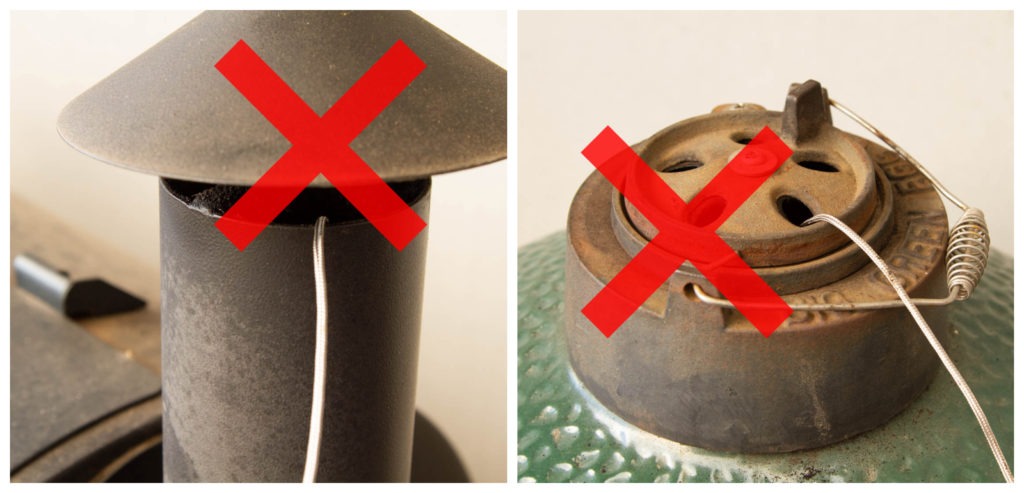
Solution
The solution here is to not use the chimney. Most smokers have some kind of grommet, port, or cut-out that is intended for probe cables. Use it! And if your smoker doesn’t have such a port or you don’t feel comfortable creating your own, it’s actually better to simply close the smoker lid on your probe cables than to thread them down through the hot chimney.
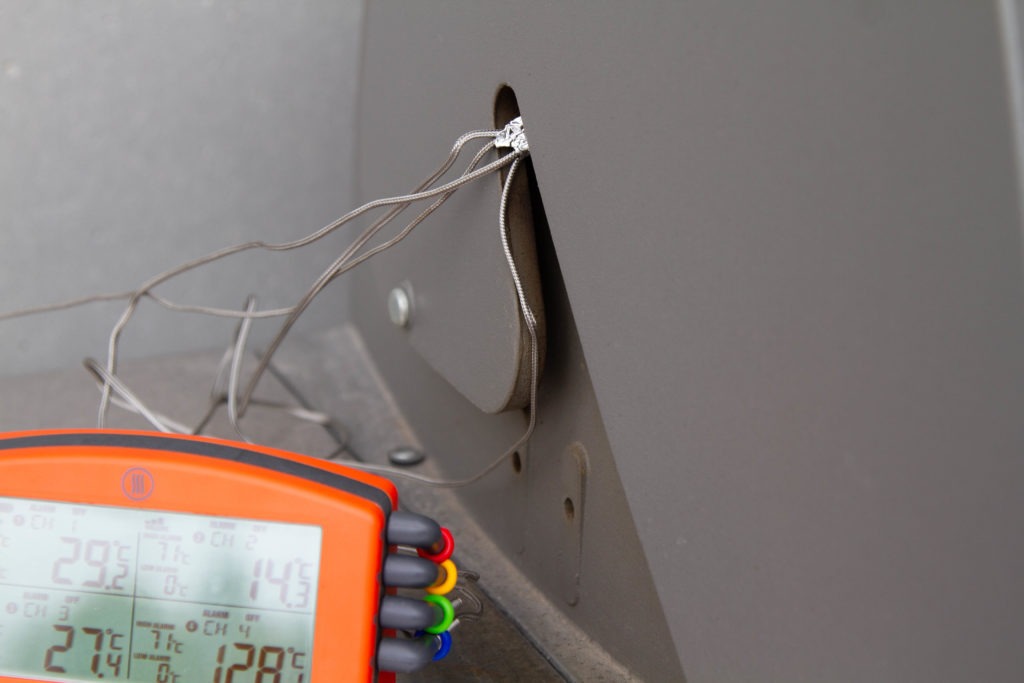
2) Placing cables over hot spots
As we’ve noted already, there must be fire to make smoke, and even the smoldering of the woodchips is over 1,000°F. Despite the systems of diffusers and baffles that are meant to protect your meat from the high heat, there are places in the smoker where that heat is accessible. Every smoker has hot spots, and a good pitmaster will know not only where those spots are, but how to use them and how to avoid them.
Because of the variety of smokers, it may be instructive to take a look at a few common smoker types to learn about hot spots and how to avoid them.
Pellet smokers
Most pellet smokers have a drip tray that acts as the main heat diffuser. The fire burns underneath the tray, and the tray itself heats up, acting as a radiant heater for the meat. However, some of the heat from the fire also comes up around the sides of the tray. On some models, the tray can be moved, and it’s best to move it as close to the front as possible so that if you need to run your cables through the lid you won’t be crossing a hot zone.

Egg-type or ceramic smokers
These smokers use ceramic diffuser plates that absorb and slowly radiate the searing heat from the coals. The three-legged design, however, creates ample opportunity for probe cable destruction. If you don’t run your cables into your smoker over one of the three legs, you expose the cable to temperatures that easily surpass their temperature ratings. Make sure you are crossing a ceramic bridge when you are setting up your probes.
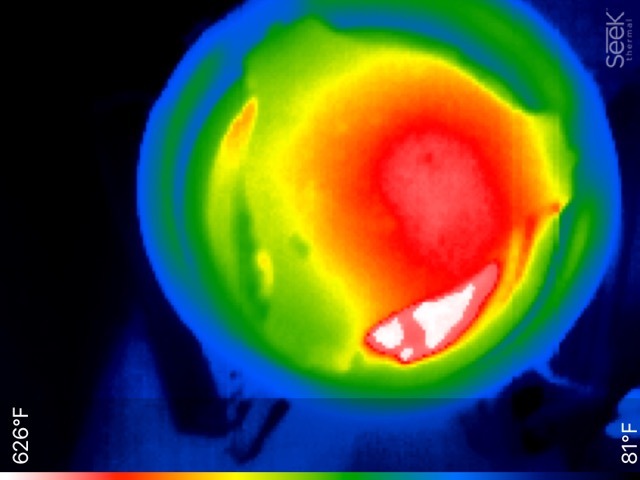
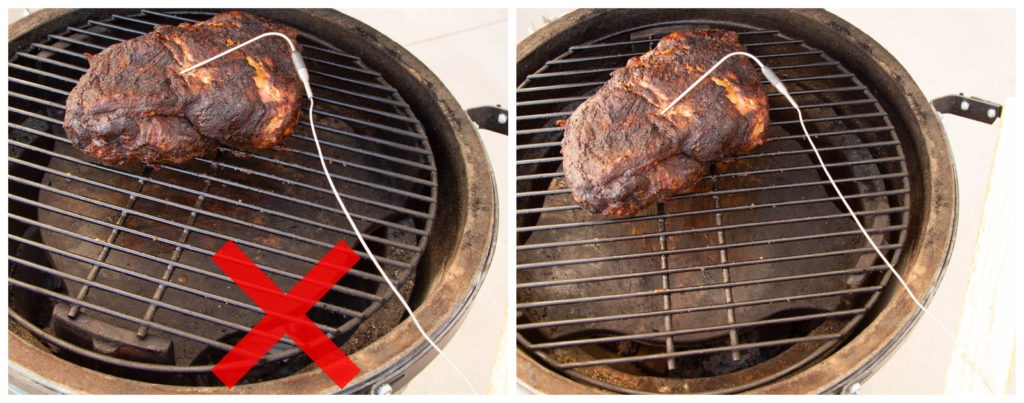
Offset smokers
Offset smokers have a firebox on one side, with all the heat entering the smoker from a small opening at the junction of the firebox and the smoking chamber. The area closest to that opening is the hottest place in the smoker. When you run your cables into your offset smoker, do so starting on the side furthest from the firebox. While the average temperature in another part of the cooker may be low, the intense heat coming from the firebox can definitely damage your probes.

Kettle-type smokers
The hot spots in your kettle-type smoker will vary widely, depending on their design and your arrangement of coals. Be aware of where the fire is, where the direct heat is traveling, and where your cables are.
Also, a common problem for kettle grill smokers is kinking in the lid. To keep the smoke and heat in, people will press the lid down hard over the cables, sometimes kinking them. If your kettle has a hole or grommet port for probe cables, be sure to use it!

3) Placing the transition over the water pan
In some cookers, especially the Big Green Egg type, a water pan can be placed over the fire to act as a diffuser This provides the added benefit of steam produced in the water pan which helps to transfer heat more efficiently to the meat. But if you aren’t careful with your probe placement, the water pan can be a hazard. If the probe transition extends out over the water pan, the hot steam that is produced can penetrate the otherwise water-resistant seal and condense inside the probe, causing it to short out.
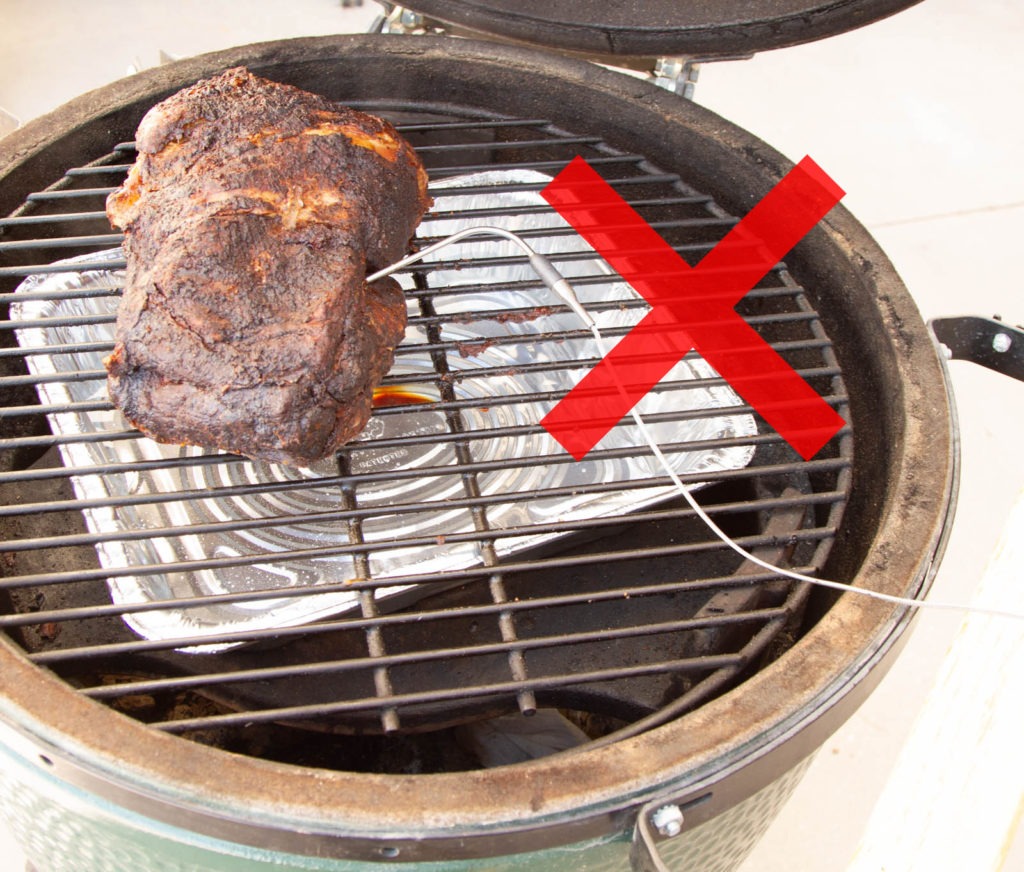
Solution
To prevent this, avoid inserting your probe laterally into the meat. When you insert the probe from above, instead, the mass of the meat itself can baffle the steam so that it doesn’t penetrate the probe transition. This isn’t really an option for some cooks like a whole turkey, which really should be probed laterally, but for most smoking projects, try to insert the probe from above.
Note: Because of the nature of the two technologies, this is really only a problem for the Pro-series thermistor probes, not the Type-K probes. If you have a water smoker or often cook with a lot of steam, it may be best to invest in Type-K technologies.
4) Laying cables across grates
One of the easiest mistakes to make when handling your probes is allowing the cable to rest on the grates of the smoker or, even worse, droop down below the grates. Why is this a problem? Because the grates are, well, great conductors of heat. As we’ve already discussed, every smoker has hot spots where the heat from the fire is more direct, despite all the diffusion plates and baffles. The metal in the grates can channel that heat more directly than the surrounding air, meaning that while the probe itself is tucked safely in your brisket, the cable might be draped across a grate that is 700°F (371°C).
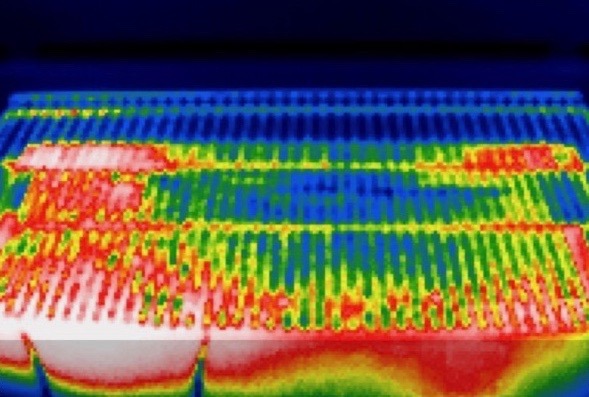
Likewise, if your cable droops down below the grate, you can greatly increase the chances that it will encounter hotter temperatures. Heat propagates by what we call the “inverse-square law,” meaning that if you double the distance from the heat source, you cut the intensity to a fourth—triple the distance and the intensity drops to a ninth. Conversely, if you halve the distance to the heat source, you increase the intensity of the heat by four times. A cable that droops down below the grates may be experiencing much higher temperatures.
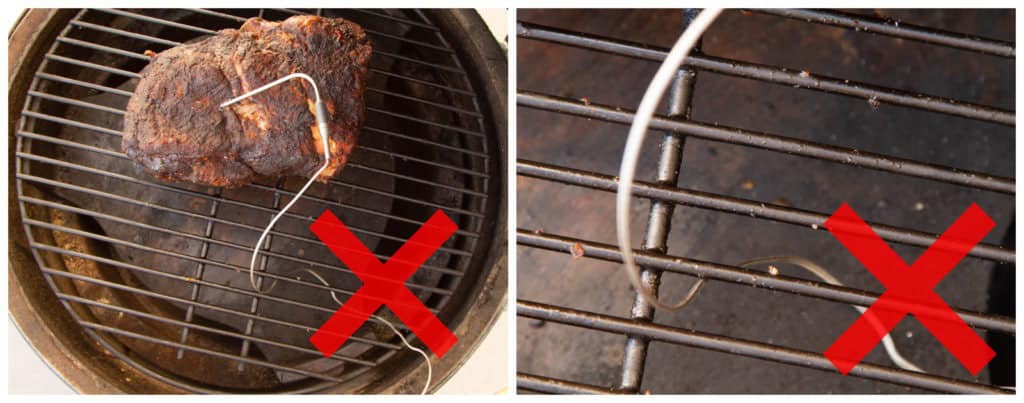
In an associated probe failure, people sometimes let their cables rest on top of or against the sides of the smoker. Again, though the air inside the smoker may only be at 275°F (135°C), the metal on the sides or top of the smoker may be much hotter.
Solution
When you feed your probe cable into your smoker, be sure there is enough tension in the cable to keep it from drooping. If there is not enough tension when you run your cables through your grommet or cable port or lid, you may need to move your thermometer further away from it to create very light tension. You don’t want to stretch the cable so hard that you pull on the transition spring, but be sure that any loose cables do not drape themselves against the side of the smoke chamber.
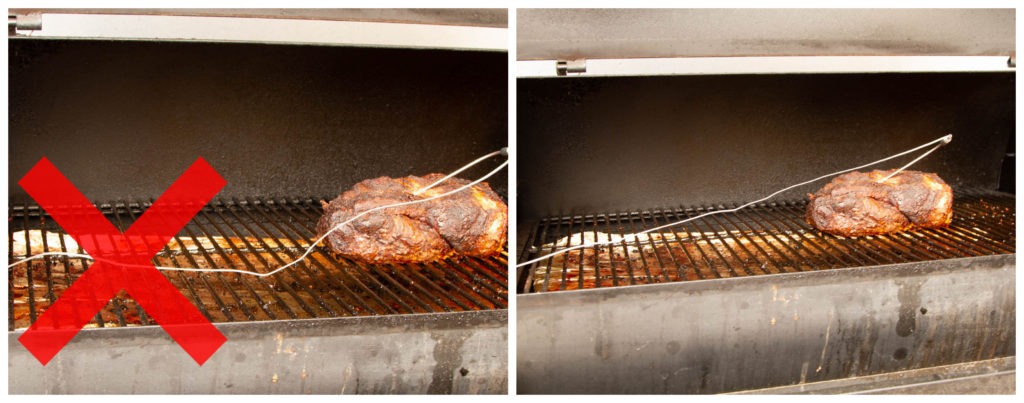
Sometimes when people turn their meat they’ll pull the probe out and, without thinking, set the probe on the grates where not only can the cable get too hot, but the probe tip itself can drop below the grate into the hot zone. When you remove the probes from the meat, be careful to remove them from the smoker.
Some other helpful tips
Foil
Some people use foil to help protect their probes, wrapping the cable to protect it from hot spots. This is an excellent idea, but it must be done correctly. If your cable must cross a hot zone, wrap the section over the hot zone in a ball of foil that doesn’t extend beyond the hot part. Wrapping the entire length of the cable in foil can actually channel hot air down the foil tube of foil to the transition. Use foil to wrap where needed, but only where needed.
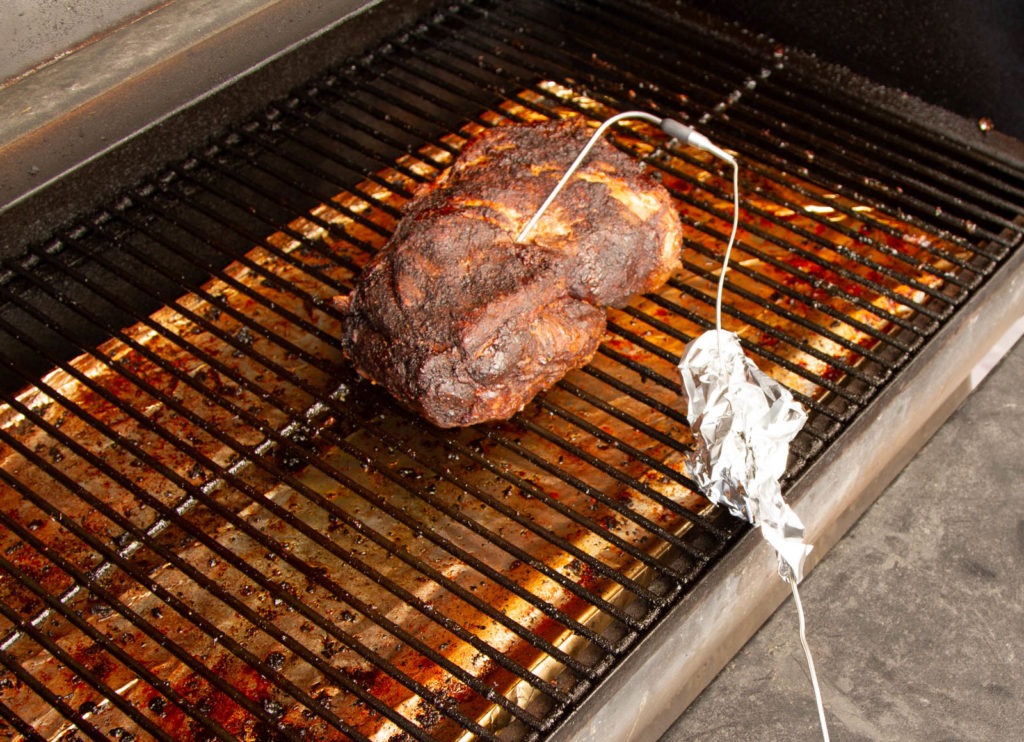
Kinking and storage
If a cable becomes severely kinked, it can break the wires inside, causing a short and probe failure.
To prevent kinks from happening, be careful how you spool and unspool the cable. Much like a garden hose, if you pull a cable taut from a coiled position, it will kink. Also, when you go to store your cables, coil them loosely around your hand, not tightly around your thermometer. The kind of tension you apply when wrapping a cable tightly can actually damage the wires inside.
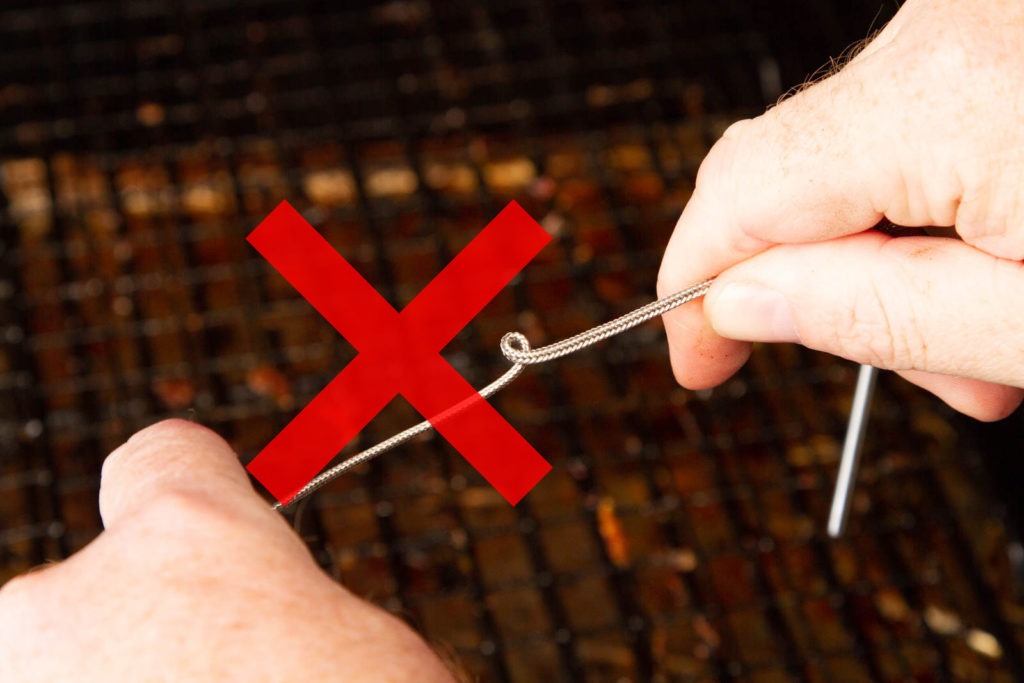
Flare-ups
It’s a fact of life. All smokers have flare-ups—even pellet smokers. Improper cleaning can cause an accumulation of flammable material inside any smoker, leading to unexpected fires. Non-mechanical smokers are prone to flare-ups from dripping fats. All it takes is one tongue of flame rising above the grate surface to burn out a probe. So keeping your smoker clean can help you extend the life of your probes.
Pulling on the cables
Some people like to remove the probes from their cooked meat by giving the cable a sharp tug, but that can weaken or break the seals at the transition that help to protect the sensor. A much better way of removing the probe from your meat is to grip the probe at the bed or at the transition and pull it out.
Conclusion
Whether you barbecue for your family or for competition, careful temperature control is essential to your success. Accurate, durable probes make that kind of control possible and ThermoWorks probes are the most accurate and durable probes around. That said, a little extra care can go a long way in extending the life of your probes. Take care to avoid chimneys, vents, hot spots, metal grates, and the hot steam from water pans. Avoid kinking your probe cables and use foil only sparingly.
Shop now for products used in this post:
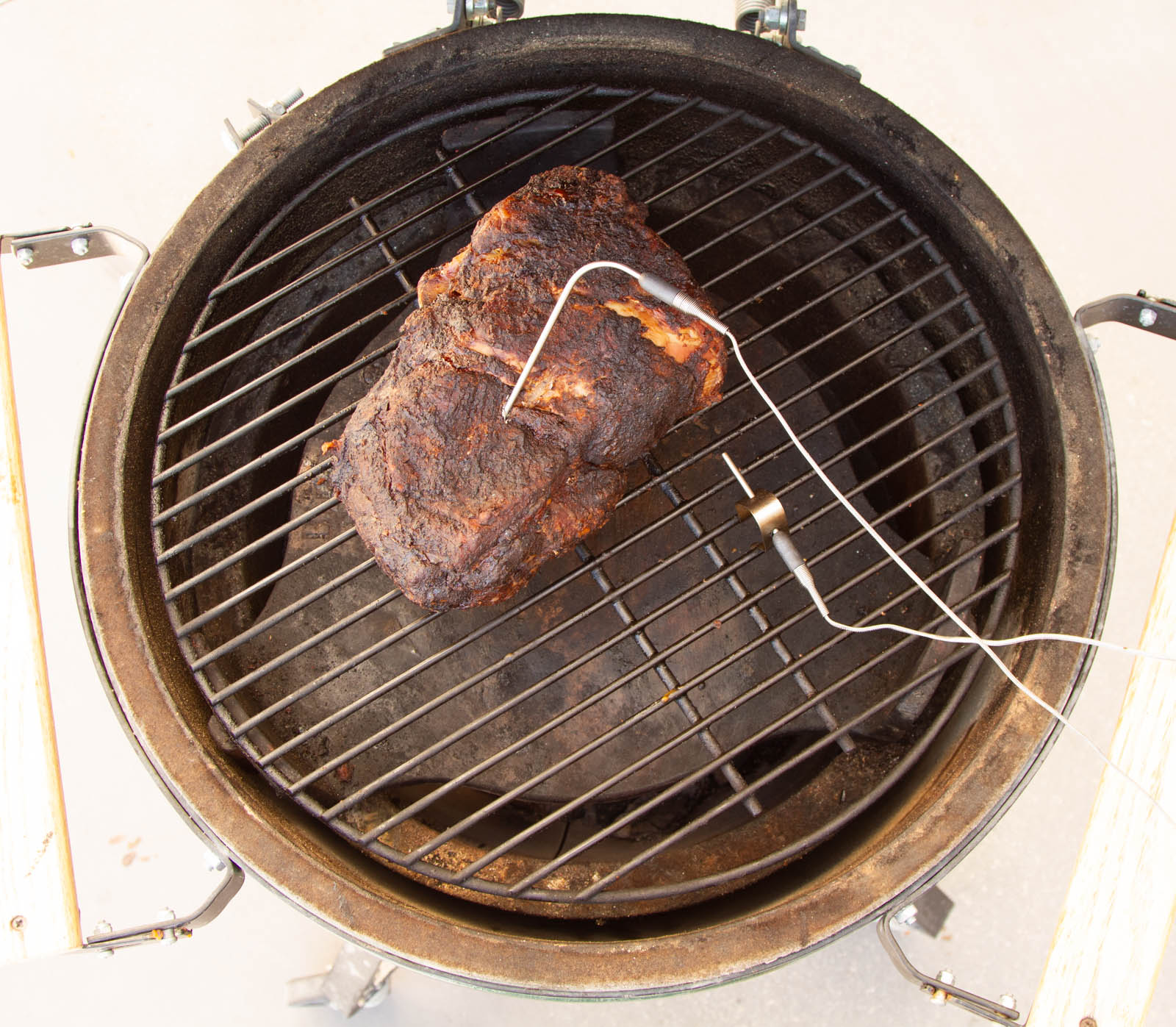
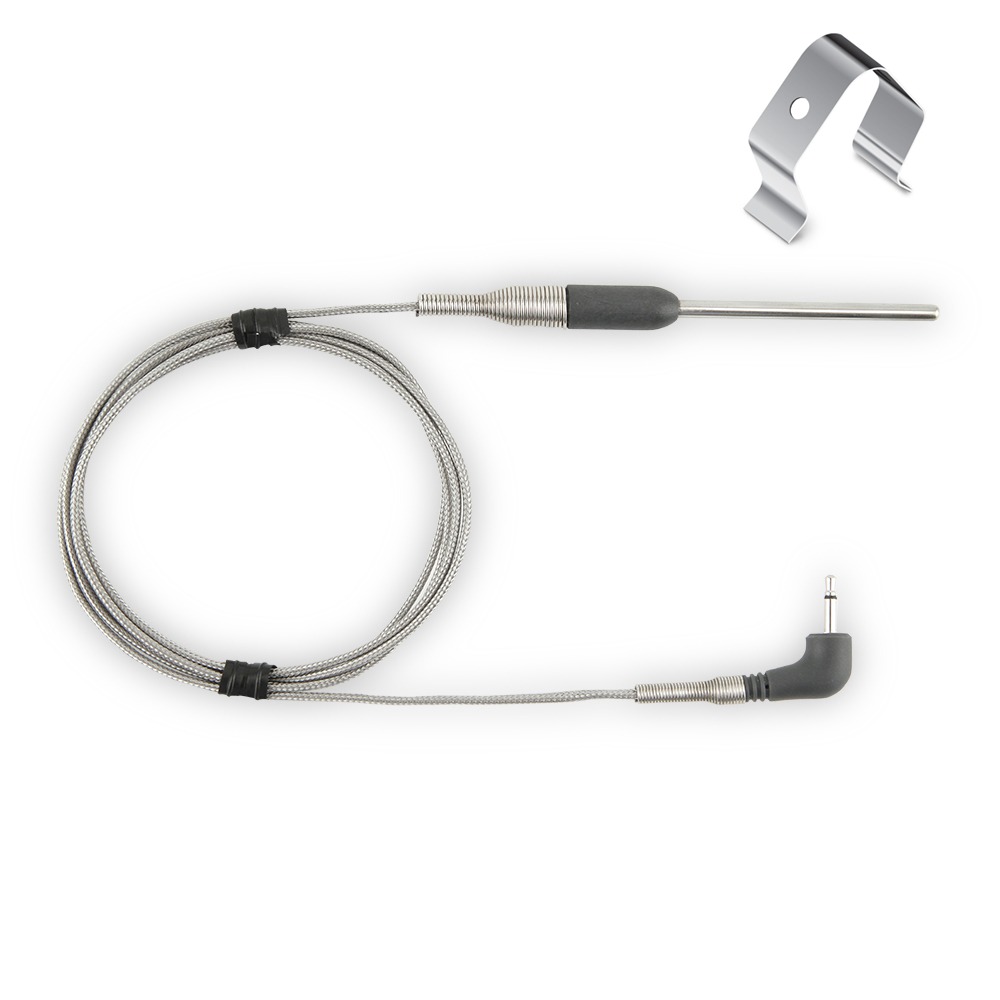
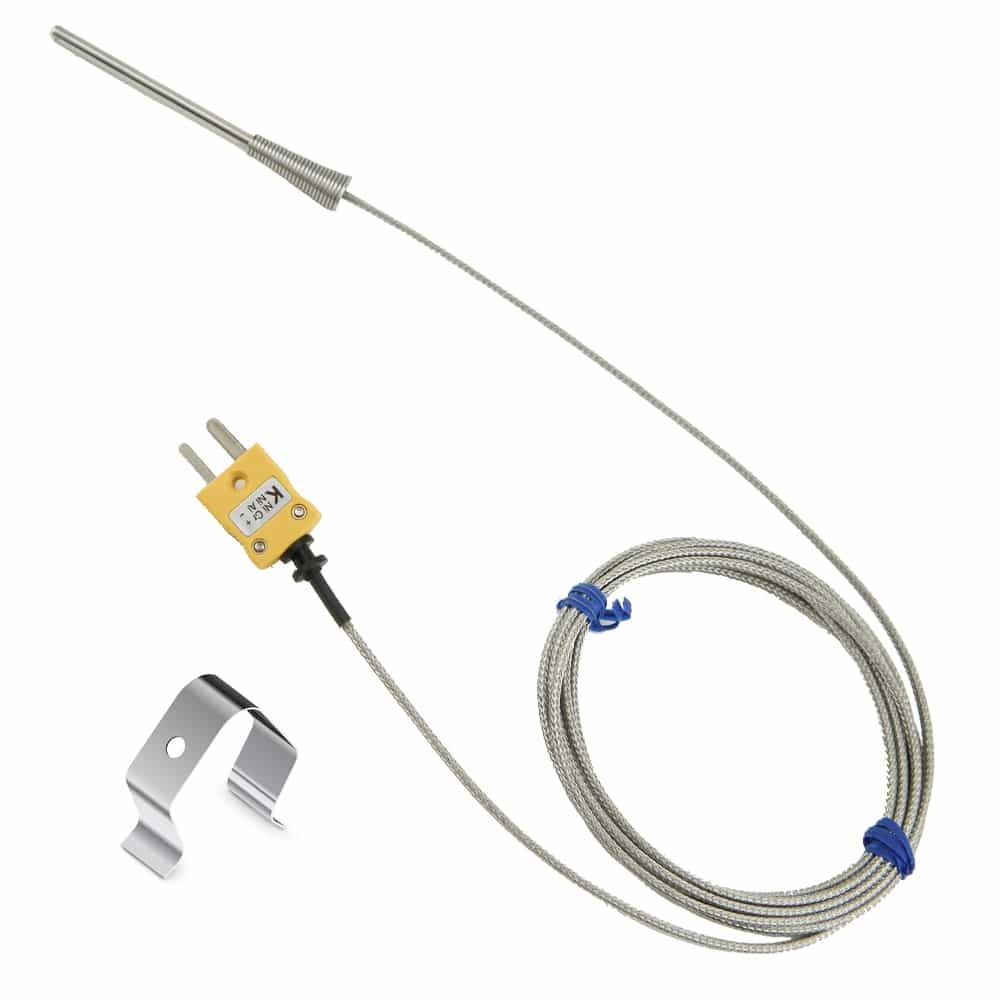

Jim Brown says
Thank you for the detailed information on how to best take care of the probes. I will forward this e-mail to friends to whom I have given your SMOKE thermometers as gifts.
Martin says
Jim,
Great!
James says
Common sense! Thanks.
Sue Hamilton says
We have a Weber Summit Charcoal Kettle. It has no cable port but it does have a substantial gasket. We have no option but to close the (heavy) cover onto a cable, unless you have another suggestion.
Martin says
Sue,
The wide gasket on the Summit distributes the weight of the heavy lid evenly across the closure, rather than pinching the cable in one place. It’s the pinching you need to avoid!
Jim D says
Hi Sue,
I just take whatever’s around, like a stick or a crumpled piece of foil, to make a small space so the wire doesn’t get crushed.
Happy smoking
Jim
phil says
This article is one reason I really appreciate your company!
I still am trying to figure out how to use the probe and cable with my smoker. It is a Cookshack and the door shuts very tightly, there is no grommet, and the chimney seems to be the only way to get the probe into the smoker. Any ideas?
Also, same thing with the Weber kettle grill. There is no grommet, and other than the chimney and through the bottom vent, the only way to enter the grill area is under the lid. Your article did not say whether that is proper or not, only that it can kink the cable.
Thanks again!
Martin says
Phil,
If your smoker has no grommet and no gaps that are meant for cables, some people will install their own port/grommet. Doing so may void your smoker’s warranty, but some people don’t mind that.
Depending on how your lid closes, the risk of kinking may not be very bad. Look at how it closes, and examine the situation. A slight risk of a kink may be better than an increased risk from feeding it through the chimney.
For the kettle, it’s ok to go under the lid if you let the lid rest lightly on the cable rather than crimping it in. Very little smoke or heat will be lost.
I hope this helps!
Ken says
I purchased some 1/8 in. food grade silicone tubing and sliced it in half lengthwise. Using about an 18 in length, I slid the probe cable in the tubing and let that protect the point where the lid and weber kettle bottom meet. Works great, and no probe failure after many many cooks.
Martin says
Ken,
Nice tip!
Milt Miles says
Thanks!
arthur mournian says
I am just beginning to use my new equipment, little chance since Christmas. I have read and saved some recipes, really good.
This article is absolutely great! I have had other probes fail and following these hints/instructions should reduce the damage to the new probes, thanks a million.
I have to say I had no idea there were so many different units available and actually used.
Martin says
Arthur,
I hope you find some time to use them soon!
Happy cooking!
CaptTurbo says
You will never experience a “flare-up” in a KBQ smoker. Just sayin’ … 😉
Jim says
Being new to using a wood burner, this is very helpful, thank you.
Mike Czechowski says
After numerous low & slow cooks, the probe cables get pretty grungy. What is best way to clean them? The probes themselves clean up pretty good with damp Scotch-Brite pad, but what about the woven cable covers?
Martin says
Mike,
We recommend that you clean the probes with a damp cloth and kitchen cleaner (a degreaser type is good) after each use to keep them less grungy.
Mickey says
Soaking the cable without submerging each end that you don’t want to get water into makes cleaning a lot easier. Suspend the “dry” ends, experience will tell you how long to soak. I use the soaking technique with the grills for my smoker by putting them in a appropriate size garbage bag, laying flat on ground then covering the grill with water, tying the opening closed and putting the knot/opening on top so the water doesn’t run out. Clean up a lot easier…
Martin says
Mickey,
We recommend against that method. While our cable construction is moisture resistant, it is not waterproof. Soaking may lead to faster deterioration and failure of the probes.
John says
I clean mine with purple power cleaner. Quick spray and it melts that grunge. Sometimes I kelp it along with scotch bright.
Mike B says
I’ve found that it is really easy to avoid kinks by coiling around a can of soup and slipping it off. It’s a way to untwist a section and also use one of the hundreds of twist ties I have left over from storage bags.
John says
Grate (sp) post, thanks. I have a kettle grill and I drilled a small hole just above grate level to insert my probe. I always try to place my probe the farthermost from the heat source without touching the meat. This means I am cooking at a slightly higher temperature than the reading, but not much. Love my ThermaQ. Makes me a successful butt man and candy maker (fudge)
Martin says
John,
I love it! Happy cooing!
Tom Ray says
I have an Egg and an offset smoker.
For the Egg, I cut an approximate 1/8″ slot from the bottom gasket to leave an opening for my cables. This is tight enough to hold the cable taut to keep them off the grate but does not pinch them when the lid is closed.
I lined my offset smoker doors with the same gasket material as used on the Egg but left a small gap at the bottom corner, farthest from the fire box, to create a probe cable channel. This also serves to route the cables up and off the grate.
Martin says
Tom,
Great thinking!
low and slow says
Thankfully the rod holes on the PBC allows probe cables easy and safe access.
Patrick j. Unkel M.D. says
You are missing a simple method of protecting the cable over the hottest, most dangerous areas of the fire. For years, I fold a piece of heavy duty foil into a piece 2’’ wide and long enough to make sure it covers any area that might be over a flare up. This, i wrap tightly around the cable!
Actually, when i am finished i leave the foil cover on. I do a lot of hot grilling, but can’t remember tha last time I burned out a probe. Only draw back, need a little extra room for storing, but that is a small price to pay.
Could not cook with out your equipment!
Robert Foye says
A very helpful article with good photos.
At one point in Section 4 it refers to heat propagating in accordance with the “inverse-square law.” That’s certainly true for “heat” such as infrared. Hopefully people will remember all the cautions you provide and not move the probe/cables further from the “heat” and into one of the hot spots you mentioned.
Patrick Smith says
ThermoWorks should include a storage device for the probes. This should be something that users can wrap the cords around to keep them untangled and unkinked.
N says
They do have silicone probe spools! They work great. https://www.thermoworks.com/silicone-probe-spool/
SkyDog says
I smoke 4 butts at a time on my Green Mountain Grill pellet smoker.
I run my 4 “Smoke” probe cables thru the top/hinge side of the lid. It’s about a 3/4 inch flat steel overlap so there’s no focused crimp on the cables.
Works great. When I pull each one to wrap them in foil, I either let the probes hang in the smoker or stick it in another butt til I get it back on.
Dawn dish soap works great for cleaning cables…just don’t pull tight on the cable right at end connections. A third hand helps.
Kent Carothers says
Great article on probes. I have a camp chef and it has a hole for the cables to pass thru. When using more than 1 probe does it matter if the cables touch? Also can you tell me if your probes are compatible with the camp chef probe connections?
Martin says
Kent,
The cables touching is no problem at all. Go for it!
As for the Campchef, it will not read our probes correctly. The ‘calculator’ in its computer uses a different curve for calculating temperatures than our probes produce.
Dan says
the wire connections in my K type probes keep coming loose inside the yellow connector. You have repaired them once and I have done it myself three times. I am always careful when I use them but it seems to be a recurring problem. Any ideas?
Martin says
Dan,
It sounds like something is happening that is pulling on the cable. For some people that happens in the wrapping and storing. Might that be it? It’s not a problem we hear about very often. If the problem persists, I recommend speaking with our tech support team, they are fantastic at diagnosing such things.
Don R says
With my PitBarrel Cooker, I run the cable through the openings for the rebars I Hang things on. Any thoughts about the wisdom of doing that?
Martin says
Don,
Go for it! Just don’t pinch the cables between the rods and the thin wall of the cooker.
Matt T says
On the PK 360, I typically run them through the vent on the opposite side of the coals. But it sounds like this is incorrect. It’s better to close the lid on the cables? The PK is cast aluminum which I would imagine gets extremely hot as well.
Martin says
Matt,
That’s a tricky one! I would say feeding the cable in through the lid on the side opposite the coals would be your best bet. Yes, the cast aluminum will get hot, but I’m pretty sure it’ll be better than the vent. You could test the temperature of it to see if it’s too hot.
Graham says
Pit Barrel Cooker owner here. Would you recommend putting the probes through the rebar holes or just close the lid on the cables? Thanks!
Martin says
Graham,
Go ahead and use the rod holes, just be sure that if you use the rod you aren’t pinching the cables with them.
Richard Boettger says
I always use aluminum foil to shield the cable but I didn’t realize the harm in shielding the entire length of the cable within my BGE, so thank you for that tip. It is worthwhile to use the foil with the shiny side OUT to deflect as much heat as possible.
Martin says
Richard,
Excellent point! keep that radiant heat out as much as you can!
wilson says
Thank you for this valuable information.
I use a Weber Smoky Mountain smoker that comes with a grommet for threading the probe through. Often I need to thread 3 probes through this port. When it is time to take say the brisket out to wrap, is it safe to keep the probe inside the smoker for an extended period of time? It is quite challenging to take 3 hot probes out from the smoker, because with an opened lid the fire heats up very quickly. Any suggestion as to how to properly keep the probes in the smoker while the fire wind down. Thanks in advance.
Martin says
Wilson,
Great question! This may sound weird, but you could use a large sponge to stick the probes into while you wrap the brisket. That would keep them from dangling into the chamber or laying on the hot rack, and it’d be easier than extracting and rethreading all the probes through the hole.
kirk poenicke says
Great tutorial on the proper care and use of cables
Thanks
Marvin Patterson says
I have never used this item but because you guys are so awesome ? with this kind of info I certainly will probably be ordering one in the near future, So great to see this kind of customer service along with excellent products. Kudos, Kudos!!!!!
Martin says
Marvin,
we look forward to hearing from you! Happy cooking!
Ray Ritter says
I recently got a electric smoker. It has a small opening in back of unit to let smoke out would that be ok to run my cable thru. I have a maverick 33 thermometer.
Thanks
Martin says
Ray,
If the opening isn’t at the top where all the heat can be concentrated, it should be fine. We’re really trying to avoid situations like in a ceramic egg smoker where all the heat rises and exits the smoker at one point. See the comments on the pit barrel cookers. It’s a similar situation.
Tom says
I use “The Smoke” dual probes with a Pit Barrel cooker. Because the lid needs to sit totally flush or the temps tend to get too high, I run my probes through one of the 4 holes near the top where the two rebar rods are inserted. These could be thought of as 4 small chimneys in that the exhaust gases and smoke exit through these 4 holes. The only real other option would seem to be to drill a port for the probes near the top of the barrel. Noah, Pit Barrel owner and president says to run the probes through one of those holes which I have been doing and so far no probe failures. Wondering what you would recommend. One thing I have never thought to try but will next time I fire it up…….hold the tip of my Thermopop in the center of one of these holes and see what it reads……..
Martin says
Tom,
For the PBC, using the rod holes is a good idea. While the holes can act in a chimney-like manner, they aren’t at the top of a dome where all the heat is concentrated before leaving. Just be sure that if you use the rods, they aren’t pinching the cables! And using your Thermapen in the openings would be interesting just to know!
Mark E says
What about a grate clip that elevates the wire off the grate?
Martin says
Mark,
That’s exactly why we provide grate clips! The grate clip adds elevation to the probe so that it needn’t lie on the surface. If you’re concerned about the grate clip transferring heat, you can rest easy. The wide shape of the grate clip is designed to vent heat rather than transfer is easily.
Doug says
I have a Pit Barrel Cooker and run my probe wires through the rod hanger holes. Is this the best method for a Pit Barrel Cooker?
Martin says
Doug,
As long as you don’t let them droop down by that hot fire basket, it’s a great way to go. Also, be careful if you’re using the rods that they don’t pinch the cable against the cut out in the barrel wall.
Robert says
Your warning about steam entering a probe has me wondering about their utility in water smokers. I cook with a Backwoods, which as you probably know bathes the food in quite a bit of steam along with the smoke. While there are no hot spots to worry about, this is a high moisture environment. Is this a concern? I am using your type K probes.
Martin says
Robert,
For the Type-K probes, steam isn’t an issue. (I’ll make that correction in the post.) Because of the nature of the sensor itself, even if a little moisture does enter the probe, it’s not a problem. Carry on!
Joe Janak says
I don’t understand how wrapping the entire cable under the bbq pit cover can channel heat “down” to any place. And were is the “transition” you state that it channels heat to? Transition of what?
I’ve been wrapping the entire cable from the probe to the outside of the pit lid with several layers of foil.
Martin says
Joe,
The transition is the place where the cable meets the penetration probe. If you wrap the whole cable and if the foil is situated over a hot spot and the probe isn’t, the hotspot can heat the air in the foil, causing it to get piped along the length of the cable to the transition, which can’t take the hot-spot heat as well. It won’t necessarily fail, but the chance is slightly greater.
Terry says
I’m using a Masterbuilt Electric Smoker. It doesn’t have a chimney, but it does have a vent ring at the top that I keep open. I don’t see any other option except to close it in the door, which I was afraid would squeeze it too hard. I’ve run other inferior probe cables through the vent opening and they’ve failed. I’m eyeing up the ThermoWorks Smoke and hoping the heavier duty cable will last longer. Should I run it through the vent opening like I’ve been doing or close it in the door?
Martin says
Terry,
It’s going to be better to close it in the door than run it through the vent opening. It’s the lesser of two evils, in this case.
I do recommend the Smoke, by the way. It’s super fun and I love mine.
Steven Barre says
“Wrapping the entire length of the cable in foil can actually channel hot air down the foil tube of foil to the transition. Us foil to wrap where needed, but only where needed.”
So don’t wrap the transition?
Martin says
Correct!
Stephen Fox says
This article is a welcome, practical review of common causes of probe failure. I have damaged many probes in my time, and this information is very helpful. Thank you for posting. I do want to point out, however, that the thermal images are (IMHO) misleading. For example, the ceramic egg image shows a hot spot of over 600 degrees F. That is the thermal imager’s estimate of the source temperature. The probe cable or transition region will be exposed to radiation and convection at that point. The IR radiation will largely be reflected by the steel cable housing. The convection will depend on the local air temperature. Perhaps a better measurement would be a thermal probe embedded inside the steel cable housing at that location. Such an arrangement would give a much better estimate of the thermal load due to the unbuffered source.
Martin says
Stephen,
You are correct, that image does only reflect the source temperature, not the air temperature. And you are correct that physical probe in that location would offer a better understanding of the actual temperature.
But! it is worth noting that while the thermal imager we used shows a temperature fo ~600°F, that temperature is the max read for that device. Those coals are really closer to 1,200°F, which will have a much greater effect on a cable suspended above them.
And while a fresh, shiny probe will deflect radiant infrared heat, a well-used, smokier cable will absorb more of the heat!
You bring up some very interesting points, though!
WILLIAM A LATHAM says
I have a ugly drum smoker found out the hard way not to put the probes through the exhaust it ruin them. My question is what kind of grommet is recommend to place on the side of ugly drum smoker to run my probes through.
Thank You
Martin says
We don’t make a grommet at this time but have had good success in our personal smokers with the one that Weber makes. It’s a pretty simple install with a step-bit drill bit to make the hole. Good luck!
John Waymouth says
If I am only using the Ambient temperature of the smoker probe (not the meat probe) is it possible to turn off the “noP” alert on the receiver?
Martin says
If it’s turned on and there’s no probe, it will tell you. You could leave a probe in , but not use it, or just silence the alarm for that channel.
Robert Jarvis says
Great article. I had never considered running the probe cables ONLY over one or more of the ceramic place setter “legs.” My probes love you.